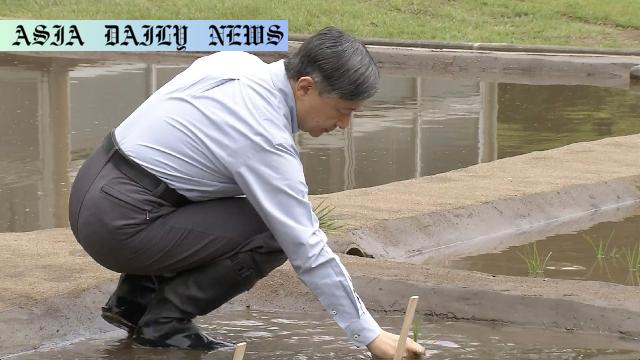Emperor Naruhito continues the cherished tradition of rice planting started by his grandfather, late Emperor Showa, promoting farming and cultural heritage.
Emperor Naruhito planted rice seedlings in the Imperial Palace.
The event continues a tradition started by late Emperor Showa.
Rice varieties include Nihonmasari and Mangetsumochi.
Harvest will be used in Shinto rituals like Niiname-sai.

Preserving Tradition at the Imperial Palace
Each year, Japan’s Emperor Naruhito faithfully continues a cherished tradition initiated by his grandfather, the late Emperor Showa, by planting rice seedlings at the Imperial Palace’s paddy field. Known for its cultural richness and historical significance, this annual event serves as a tangible reminder of Japan’s relationship with agriculture, its traditions, and its deity-centered rituals. On Wednesday, dressed in boots and armed with a spirit of reverence, Emperor Naruhito entered the 240-square-meter paddy at 11 a.m., embodying both humility and dedication to sustainable practices. This tradition is more than ceremonial; it stands as a testament to the importance of farming in Japanese culture and serves as an homage to agricultural resilience.
The Practical and Symbolic Significance of Rice Planting
The 20 seedlings planted included Nihonmasari, a non-glutinous rice variety, and Mangetsumochi, a glutinous rice variety. Carefully sown by the Emperor a month ago as seeds, the seedlings had reached a height of 10-15 centimeters by the time of planting. Such meticulous preparation underscores the Emperor’s awareness of and respect for agricultural practices. The act of planting rice not only symbolizes hard work but also serves to strengthen the connection between the monarchy and the common people, emphasizing the harmony between humans and nature. The harvested grains will not merely be consumed but will be offered to deities during significant Shinto rituals, including the Niiname-sai harvest festival in November. This integration of agriculture and spirituality reinforces how deeply the Japanese cultural ethos is embedded in practices like these.
Farming, Culture, and Environmental Advocacy
Beyond its symbolic and spiritual essence, the Emperor’s rice planting ritual sends a strong, socially responsible message about the need to prioritize sustainable farming. In a world increasingly dominated by urbanization and technology, such personal involvement by a figure of national importance illuminates agriculture’s enduring relevance. In addition, the preservation and encouragement of cultivating native rice varieties, like Nihonmasari and Mangetsumochi, resonate with the larger global efforts to promote biodiversity. Japan’s commitment to its agrarian roots as demonstrated by the Emperor is a gentle yet compelling nudge to individuals, organizations, and governments everywhere to prioritize ecological harmony and sustainability in their practices.
A Symbol of Unity and Heritage
The significance of this annual tradition extends beyond the field. By engaging in this act, Emperor Naruhito not only honors his heritage but also fosters a sense of unity among the Japanese people. This tradition reminds citizens of ancestral practices, the hard work of farmers, and the eternal cycle of planting and harvesting. It also reflects how a leader can lead by example, participating in rituals not only for their symbolic meaning but for their literal and natural importance. As fall approaches, the rice the Emperor planted will first remind the nation of the hard work invested and later take center stage in religious and cultural festivals that unite people in celebration of nature and divine blessings.



Commentary
Cultural Heritage Rooted in Agriculture
The annual tradition of Japan’s Emperor planting rice seedlings resonates far beyond the symbolic act itself. It is a profound statement on the enduring relevance of agriculture in a rapidly modernizing world. Watching a respected leader don boots and plant crops reminds the nation of its agricultural roots and the ecological harmony that comes from respecting nature’s rhythms. This act highlights the delicate balance between modernization and the preservation of tradition, a topic more relevant than ever in an era of relentless industrialization.
A Legacy of Leadership
Emperor Naruhito’s commitment to continuing his grandfather’s tradition illustrates the monarchy’s role as a custodian of Japan’s cultural and spiritual identity. By planting both glutinous and non-glutinous rice varieties, the Emperor makes a deliberate and thoughtful contribution to ensuring biodiversity is preserved. Through this event, he bridges generational gaps, connecting the wisdom of the past with the contemporary audience, who often see customs fade away under the influence of modern lifestyles.
Inspiration for Sustainable Practices
This tradition also sheds light on the importance of fostering a sustainable relationship with the environment. The symbolism of planting rice—so integral to life and sustenance—cannot be overstated in a time when global agricultural practices strain Earth’s resources. It serves as an inspiring model for both citizens and leaders worldwide, showcasing how simple, respectful acts can profoundly influence how we interact with nature.
Strengthening Cultural Roots
Ultimately, this event is not just about planting rice; it is about a nation replenishing its cultural roots, digging deeper into its values, and honoring the rhythm of the seasons. It offers a hopeful glimpse of how traditions, when upheld with care and intention, can thrive even amidst great societal shifts. By participating in this act, Emperor Naruhito aligns himself with the natural world, the people, and the traditions that bind Japan together, making this event a cherished and enduring symbol of unity.